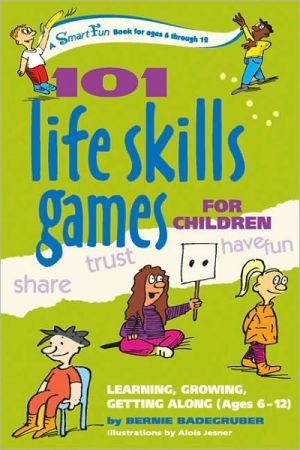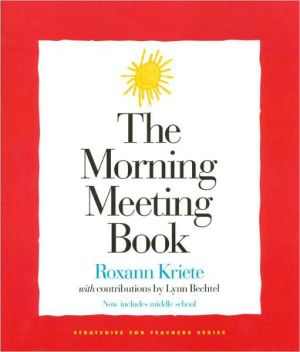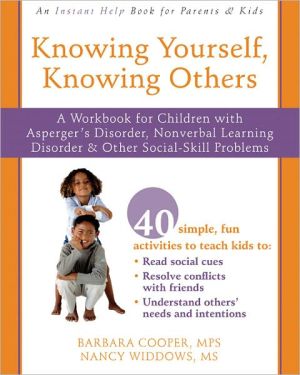101 Life Skills Games for Children: Learning, Growing, Getting Along- Ages 6-12 (SmartFun Book Series)
101 Life Skills Games for Children is a resource guide for parents, teachers, and therapists featuring games that teach important life lessons to younger children and teens. Aimed at children ages 6 to 12, this useful, fun game book is organized into three chapters: I-Games, You-Games, and We-Games. The games address aggression, resentment, honesty, flexibility, stereotypes, performance, self-confidence, respect, and group conflict. The book also offers new strategies for such problems as how...
Search in google:
101 Life Skills Games for Children is a resource guide for parents, teachers, and therapists featuring games that teach important life lessons to younger children and teens. Aimed at children ages 6 to 12, this useful, fun game book is organized into three chapters: I-Games, You-Games, and We-Games. The games address aggression, resentment, honesty, flexibility, stereotypes, performance, self-confidence, respect, and group conflict. The book also offers new strategies for such problems as how to integrate the new girl into the group and how to stop boys from fighting in line. Based on years of research, the book packs skill-building games with step-by step instructions and clearly specified objectives to help children grow as individuals and as part of a group.
101 Life Skills Games FOR Children\ Learning, Growing, Getting Along (Ages 6 to 12) \ \ By Bernie Badegruber \ Hunter House Inc., Publishers\ Copyright © 2005 VERITAS-VERLAG Linz\ All right reserved.\ ISBN: 978-0-89793-442-8 \ \ \ Chapter One\ I Games\ What I Like Games 1-5\ What I Can Do Games 6-7\ What I Observe Games 8-19\ 1 I Like This Picture\ Props: Assorted pictures from magazines (enough for all players); a small table; chairs for all players (optional); soft background music (optional)\ Goals\ Developing a self-image\ Improving the ability to introduce oneself\ How to Play: Chairs are arranged in a circle, with a small table in the center. On the table are many postcard-sized pictures of things like houses, a butterfly, a princess, a table with place settings, the sun, and so forth. Everyone takes a turn choosing a picture and, after introducing herself, explains why she likes it. A player may choose a picture that has already been chosen byanother player.\ Examples\ "My name is Lisa. I chose the picture of the sun because I like to lie in the sun."\ "My name is Thomas, and I also chose the picture of the sun because it reminds me of our vacation in Italy."\ Variation: At the beginning, everybody walks around the pictures, which have been scattered on the floor, while soft music is playing in the background.\ Note: It is not very difficult or embarrassing for children to say what they like when they're simply describing a picture-it's much easier than talking about oneself. With groups in which children know each other's names, the name introduction can be omitted. If there is a new child in the group, however, this game can be played as an introduction game.\ Reflections\ Does anyone in the group like similar things?\ Was it difficult for anyone to choose a picture?\ Follow-up Games\ 1-19: I Games * 20-26: Getting to Know You * 41-44: Warming-up Games for the Group * 52-56: Integrating New Classmates\ 2 The Run-to Game\ Goals\ Remembering names\ Making contacts\ Warming up to a group\ How to Play: After the players take turns introducing themselves, the leader asks one player to make a statement that describes another person (the statement should be neutral or positive, not hurtful). The others try to guess who the statement is about, and when they think they've figured it out they run to that person as fast as they can and shake her hand. The first person to get there is the winner and gets to make the next statement.\ Examples\ "His name is Martin."\ "Her hair is long and blond."\ Variation: After introducing themselves to each other, everybody walks around. The statement is presented while people walk around.\ Note: The children should be careful not to bump into each other when they start running. To encourage calm behavior, make a rule that if players bump into each other, they have to sit down until the next statement is announced.\ Follow-up Games\ 4: Evil Fairy's Hat * 7: Guess What I Can Do\ 3 Wishing Cards\ Props: Assorted pictures from magazines (enough for all players)\ Goals\ Expressing wishes\ Fulfilling wishes\ Being generous\ Learning to do without\ Learning that wishes can be deferred\ How to Play: After playing I Like This Picture (Game #1), most (if not all) of the players are holding a picture. If you have not played that game before this one, pass pictures of different items to each player. All the players show their pictures for about five minutes and then hold them so the rest of the group can't see them. One player starts the game by putting her own picture down and "wishing" for one of the other cards. At this point, whoever has the card she wished for has to give it to her. After that, the player who gave up his card expresses his own wish and is given the card he desires.\ Example: "My hand is empty, I wish for the picture with the sun."\ Variation: All players turn over their pictures so everyone can see them. If a player expresses a wish, he or she must also give the name of the person who is holding that picture.\ Follow-up Games\ 4: Evil Fairy's Hat * 26: The Seat on My Right is Empty (with a Twist)\ Follow-up Games from 101 More Life Skills Games for Children\ 13: Missing Person * 68: Birthday Party * 34: Picture Present\ 4 Evil Fairy's Hat\ Props: Assorted pictures from magazines (enough for all players), a hat\ Goals\ Expressing dislikes\ Finding commonalities\ How to Play: From the collection of pictures (see I Like This Picture, Game #1), every player takes one that means something negative for him. The players give reasons for their choices and then, saying "I'm going to throw it into the evil fairy's hat," they toss their picture into a hat in the middle of the room.\ Example: "I don't like the umbrella because it reminds me of rainy weather."\ Follow-up Games\ 2: The Run-to Game * 5: Good Fairy\ Follow-up Game from 101 More Life Skills Games for Children\ 17: The "I" Museum\ 5 Good Fairy\ Props: Assorted pictures from magazines (enough for all players)\ Goals\ Learning to avoid stereotypes\ Emphasizing the positive\ Expressing dislikes\ Learning to accept change\ How to Play: All players draw a picture from the "evil fairy's hat" (see Evil Fairy's Hat, Game #4). Each player tries to recall the negative reason the card was thrown into the hat in the last game and then comes up with a positive statement to counter the negative one. If the players are having difficulty remembering the negative reason why a photo was tossed into the evil fairy's hat in the previous game, the student who threw it in the hat can state the negative reason and then allow the current player to counter with a positive statement about the item.\ Example: "The picture of the umbrella was thrown into the hat because it reminded someone of bad weather, but we can have a cozy chat under the umbrella."\ Follow-up Games\ 7: Guess What I Can Do * 56: Information Please * 86: Frozen Music\ 6 I Can, I Can't\ Goals\ Improving self-esteem\ Seeing room for self-improvement\ Developing honesty\ Avoiding false modesty\ Developing empathy for the disabilities of others\ Learning to trust the group\ How to Play: All players introduce themselves, sharing something they are good at and something they are not.\ Example: "My name is Philip. I can draw well, but I'm not so good at math."\ Note: This game can help children to have a more balanced view of themselves. There will be players who only want to say something positive or something negative about themselves, but this is one rule that shouldn't be broken. And remember, everybody's better at some things than others.\ Reflections\ Which statement was easier for you-I can or I can't?\ Do you think you are self-confident?\ Do you know someone who is very self-confident?\ How do you become self-confident?\ How can you get better at something?\ Follow-up Games\ 7: Guess What I Can Do * 27-32: Understanding You * 33-40: Working with You * 45-51: Cooperation Games * 52-56: Integrating New Classmates * 57-70: Helping Games * 95: Fairytale Surprises\ Follow-up Games from 101 More Life Skills Games for Children\ 13-21: How I Am * 35-39: Perceiving You * 53: Are You Like Me? * 60-66: Integration Games * 75: President of Praise\ 7 Guess What I Can Do\ Goals\ Improving social awareness\ Improving visual awareness\ Developing self-esteem\ Avoiding false modesty\ How to Play: A player mimes what he or she can do well. Whoever guesses what it is goes next.\ Example: If a student thinks she's good at making funny faces, she keeps doing it until another player says, "Making faces!"\ Reflection: Do you find it easier to express yourself with words or in pantomime?\ Follow-up Games\ 6: I Can, I Can't * 8: Observing the Room * 20-40: You-Games * 78: Peace Language * 97-101: Pantomime Play\ Follow-up Games from 101 More Life Skills Games for Children\ 13-21: How I Am * 35-39: Perceiving You * 60-66: Integration Games * 80: Face-off\ 8 Observing the Room\ Goals\ Sharpening the senses\ Learning group solidarity\ Valuing self-awareness\ Appreciating change\ How to Play: The group leader says, in her own words: "Not all people notice the same things when they enter a room. Some notice the noise level, the quietness, or a particular sound; others notice the smell, the temperature, other people, or things in the room. Some people focus on just one thing, other people might see many different things."\ Now the group leader asks the players to close their eyes for a minute. After they open their eyes, players take turns talking about something they noticed when their eyes were closed.\ Players who mention something they don't like about the room are asked what could be changed to make them feel better. If the changes are reasonable, the group leader might consider making them as soon as possible.\ Note: Distractions in the room frequently interfere with work and play. We notice this especially with newcomers and latecomers-before they can concentrate on the other players or the discussion, they must first "take in" the room.\ Reflections\ What is unknown to you in this room?\ What makes the room comfortable for you?\ What other rooms does it remind you of?\ What things could be done in this room?\ Role Plays\ The king's daughter in the new castle. The family is considering moving into a new apartment or home. What do the family members not like now; what should be different in the future?\ Follow-up Games\ 1-5: What I Like * 9: The Room's ABCs * 10: Changing the Room\ Follow-up Games from 101 More Life Skills Games for Children\ 1-10: What I'm Feeling * 33: Favorite Place N 56: Designing a Classroom * 60-66: Integration Games N 67-73: Relationship Games * 78: Jostle\ 9 The Room's ABCs\ Props: Cards or other items with single letters of the alphabet written on them\ Goals\ Improving visual perception\ Establishing a relationship with the room\ How to Play: The group leader randomly hands out letters of the alphabet to the group, using handwritten cards or a set of carved wooden letters. The players write down objects in the room that start with the letter they have received.\ Variations\ The game can be played as a scavenger hunt. In this version, players trade sheets with each other after they have written their lists and then try to find the objects on the new sheets they have received.\ Players write down their first name vertically. After every letter, they write down the objects of the room which start with that letter.\ Example: "Ben"\ B blackboard, ball, book\ E eraser, elbow, edge\ N notebook, nail, number\ Note: Carved wooden letters are nice, and card stock lasts longer than sheets of paper, but sheets of paper are good too because they can be nicely decorated by the players and hung up in the classroom.\ Follow-up Games\ 8: Observing the Room * 10: Changing the Room\ Follow-up Games from 101 More Life Skills Games for Children\ 33: Favorite Place * 39: Two Peas in a Pod * 85-90: Statue and Sculpting Games\ 10 Changing the Room\ Goals\ Enhancing creativity\ Improving visual perception\ Developing a relationship to the group room\ Developing flexibility\ How to Play: One player leaves the room, and the others change something about the room. When the missing player returns, she has to figure out what's different.\ Reflections\ What makes it difficult to change many things in this room?\ When have you noticed something unusual in a place you go to often?\ How much do unusual things scare you?\ Role Plays\ The children acting as parents tell other "adults" how their apartment looked after they left their children home alone.\ An avant-garde interior designer suggests some crazy things.\ Newlyweds enter their new apartment and discover their friends have pulled a trick on them-like rearranging the furniture or filling a room with balloons.\ Follow-up Games\ 5: Good Fairy * 8: Observing the Room * 11: What's Made of This? * 28: You Sculpt Me * 68: Moving Help * 84-92: Statue and Sculpting Games\ Follow-up Games from 101 More Life Skills Games for Children\ 33: Favorite Place * 40: The Incredible Two-Handed Pen * 85-90: Statue and Sculpting Games\ 11 What's Made of This? Goals\ Developing tactile awareness\ Improving visual perception\ Developing ability to form pairs and work as a team\ Making contact\ How to Play: The group chooses a material, like wood or plastic or glass. Players walk around the room, touching as many objects made out of that material as possible. Touching could mean tapping, stroking, taking into one's hands, pressing, or knocking on it. Then, in turns, each player names a different object made of the material.\ Variations\ Where is there water in this room? (This variation requires good observation skills.)\ Touch any soft/small/smooth/round objects!\ Sitting in a circle, name pairs of opposites: the wall is rough, the window is smooth, etc.\ A "run-to" game: A player names a quality, for example, "round." Every player runs to a round object in the room. There can be more than one person at one object (see The Run-to Game, Game #2).\ Draw a picture or a doodle with the following titles: "round," "pointed," "water," "wood."\ Reflections\ Which materials, forms, colors, and surfaces do you like?\ Follow-up Games\ 12: The Traveling Mystery * 17: Telling Sounds Apart * 27-32: Understanding You * 39: Twins * 57-70: Helping Games * 87: Statue Pairs * 93: Bad News and Good News Pairs * 94: Fairytale Personalities\ Follow-up Games from 101 More Life Skills Games for Children\ 5: Moodles * 20: Pieces of Personality * 21: Help Wanted * 35-39: Perceiving You * 53: Are You Like Me? * 54: We Are Alike\ 12 The Traveling Mystery\ Props: Various objects to be passed around\ Goals\ Developing tactile awareness\ Calming down\ Improving concentration\ How to Play: The group leader and the players sit in a circle facing inward. Behind his back, the group leader hands different objects one by one to the player sitting to his left. The mystery object "travels" around the circle as each player passes it to the next player behind her back without looking at it. Before passing an object on, a player whispers into the ear of the person on his right (the person who passed them the object) what kind of object he thinks it is.\ Examples\ Unopened can of water\ Small building blocks\ Three marbles\ Variations\ Geometrical shapes, wooden letters\ Perfume bottles\ Note: Passing objects around a circle is a simple way of making a connection. Players not only make contact with their neighbors, they also carefully watch the players sitting opposite them: their facial expressions, how skillful or clumsy they are. These "silence exercises" tend to calm the group down and help them focus.\ Follow-up Games\ 13: A Piece at a Time * 20: Traveling Names * 33-40: Working with You * 41-44: Warming-up Games for the Group * 45-51: Cooperation Games * 78: Peace Language * 82: Vampire * 97-101: Pantomime Play\ Follow-up Games from 101 More Life Skills Games for Children\ 11: Brainstorm * 25: Zip Zap Names * 40-45: Working with You * 47: Name Chain * 51: The Goofy Game * 52-59: Cooperation Games\ (Continues...)\ \ \ \ \ Excerpted from 101 Life Skills Games FOR Children by Bernie Badegruber Copyright © 2005 by VERITAS-VERLAG Linz. Excerpted by permission.\ All rights reserved. No part of this excerpt may be reproduced or reprinted without permission in writing from the publisher.\ Excerpts are provided by Dial-A-Book Inc. solely for the personal use of visitors to this web site. \ \
Contents Preface....................xiIntroduction Thoughts on Playing with Children....................1Play Therapy and Game Pedagogy....................3How to Use This Book....................4A Brief Word on Brevity....................5Key to the Icons Used in the Games....................5I Games What I Like....................10What I Can Do....................18What I Observe....................21You Games Getting to Know You....................40Understanding You....................49Working with You....................55We Games Warming-up Games for the Group....................66Cooperation Games....................72Integrating New Classmates....................83Helping Games....................93Aggression Games....................120Adding More Imagination Statue and Sculpting Games....................146Fairytale Games....................159Pantomime Play....................167Keyword Index....................173








